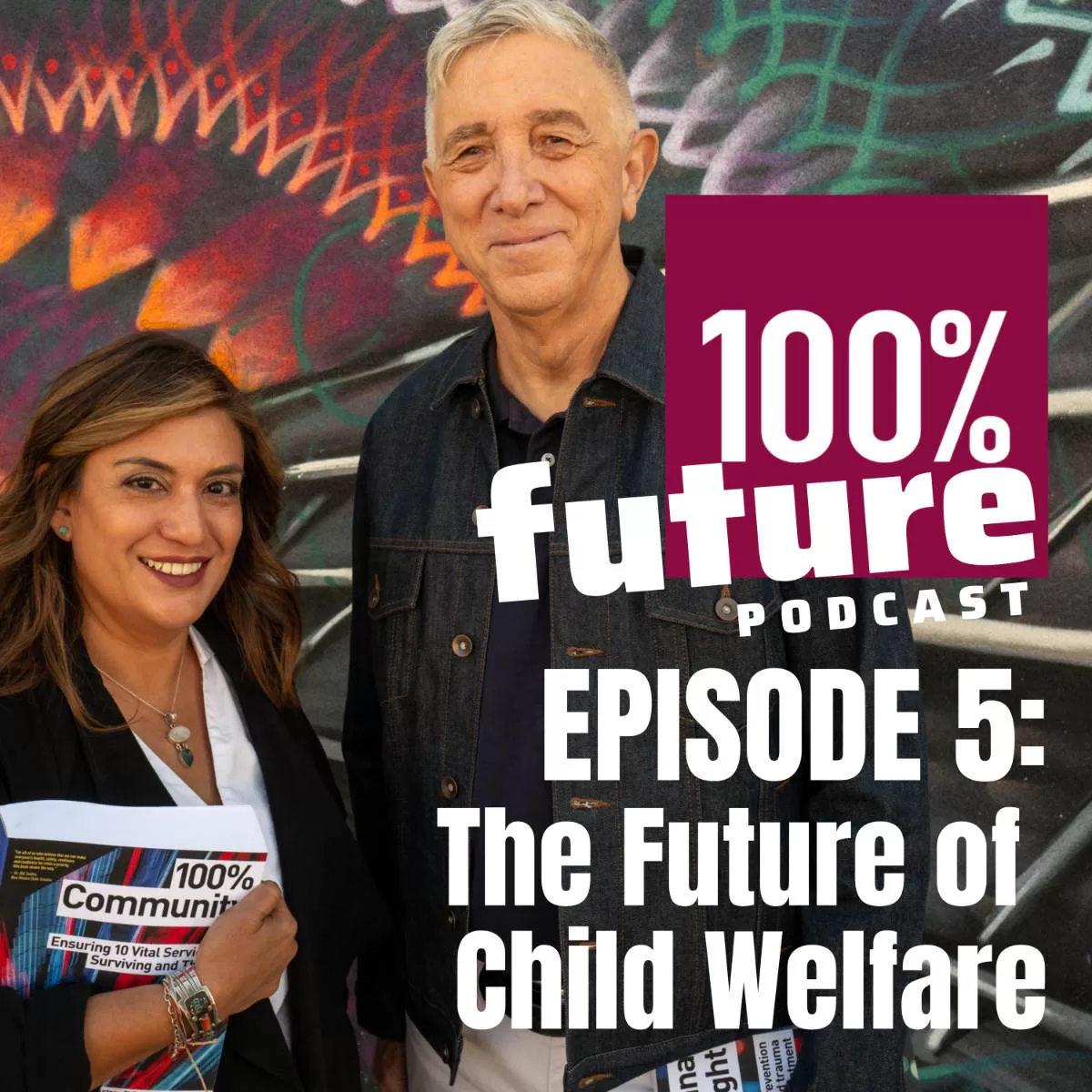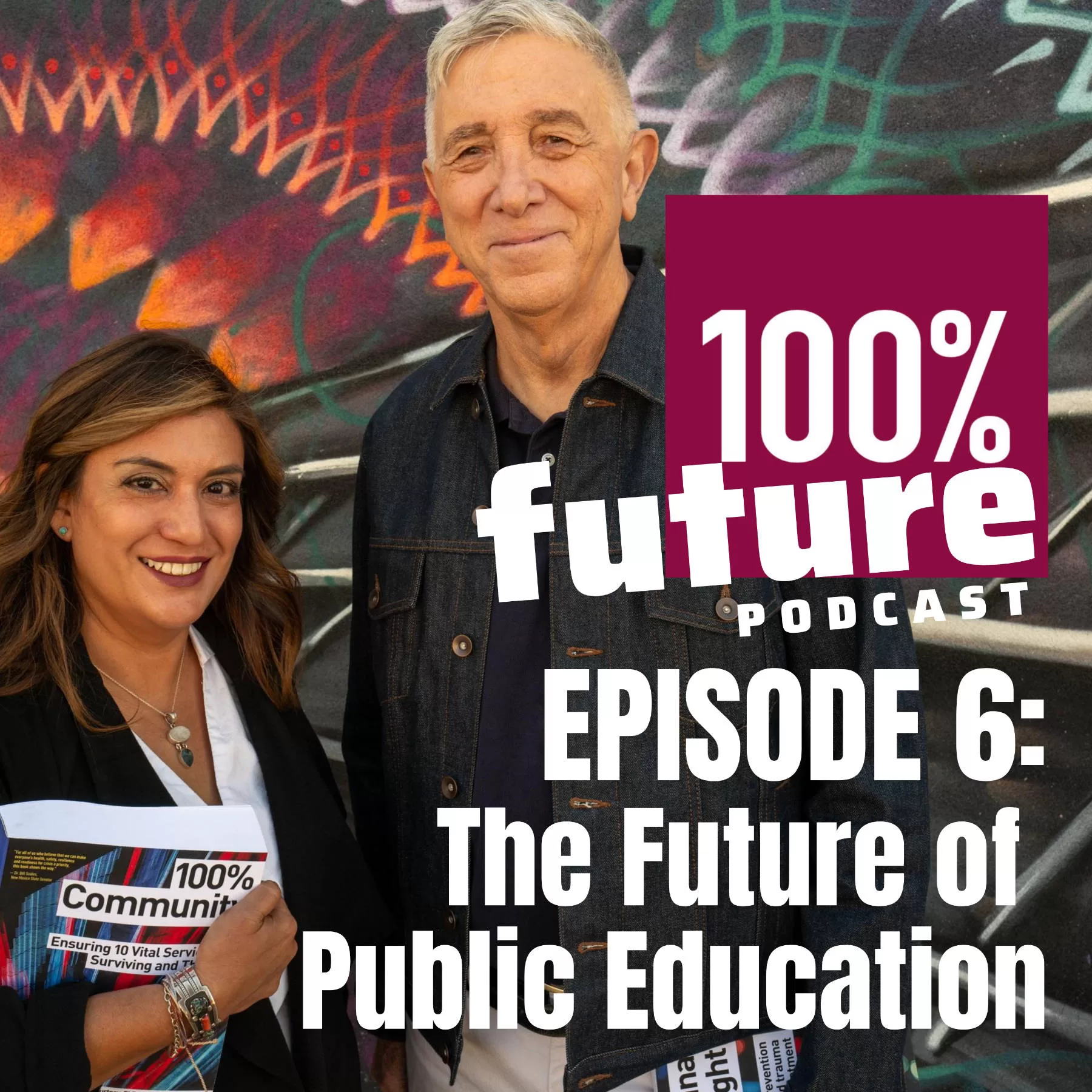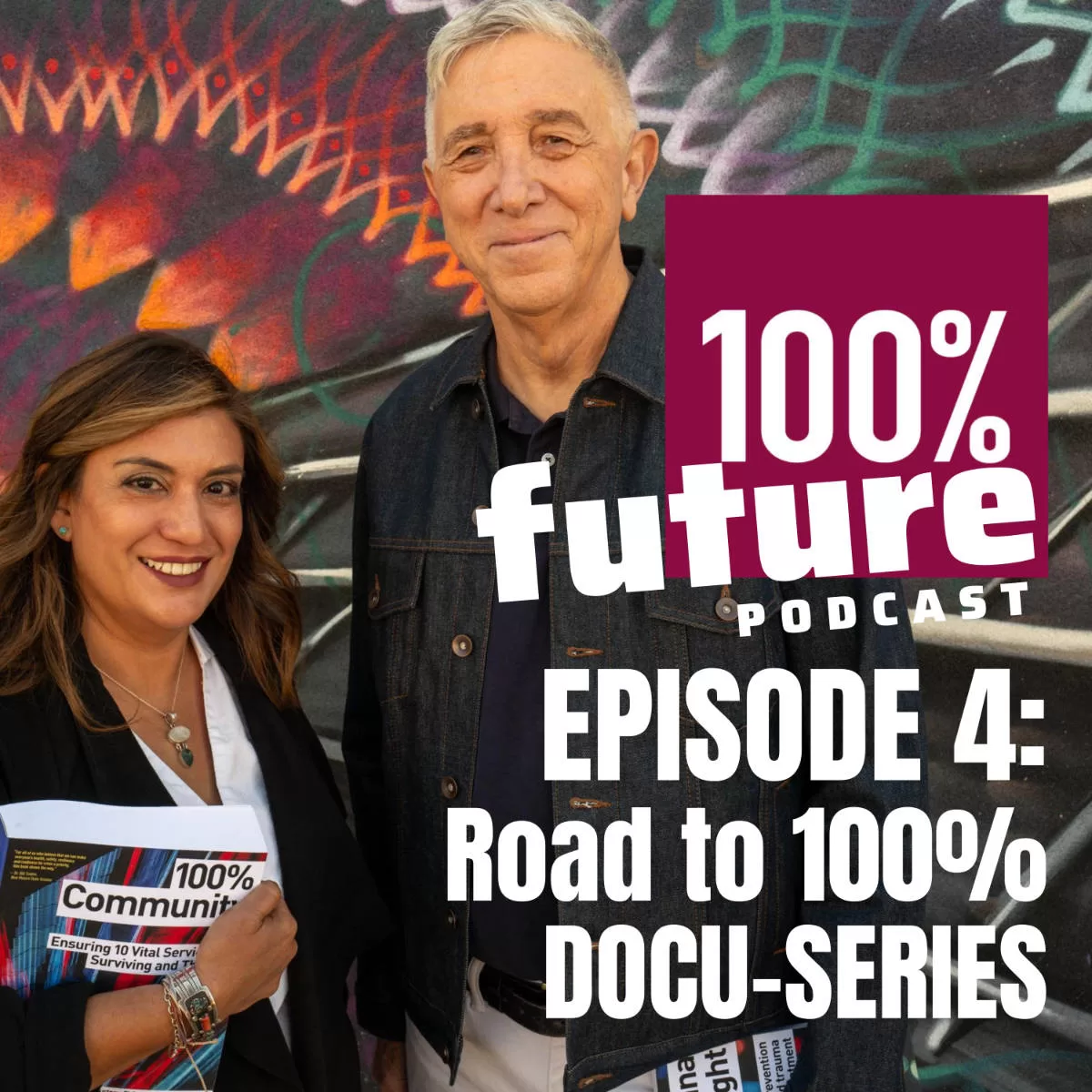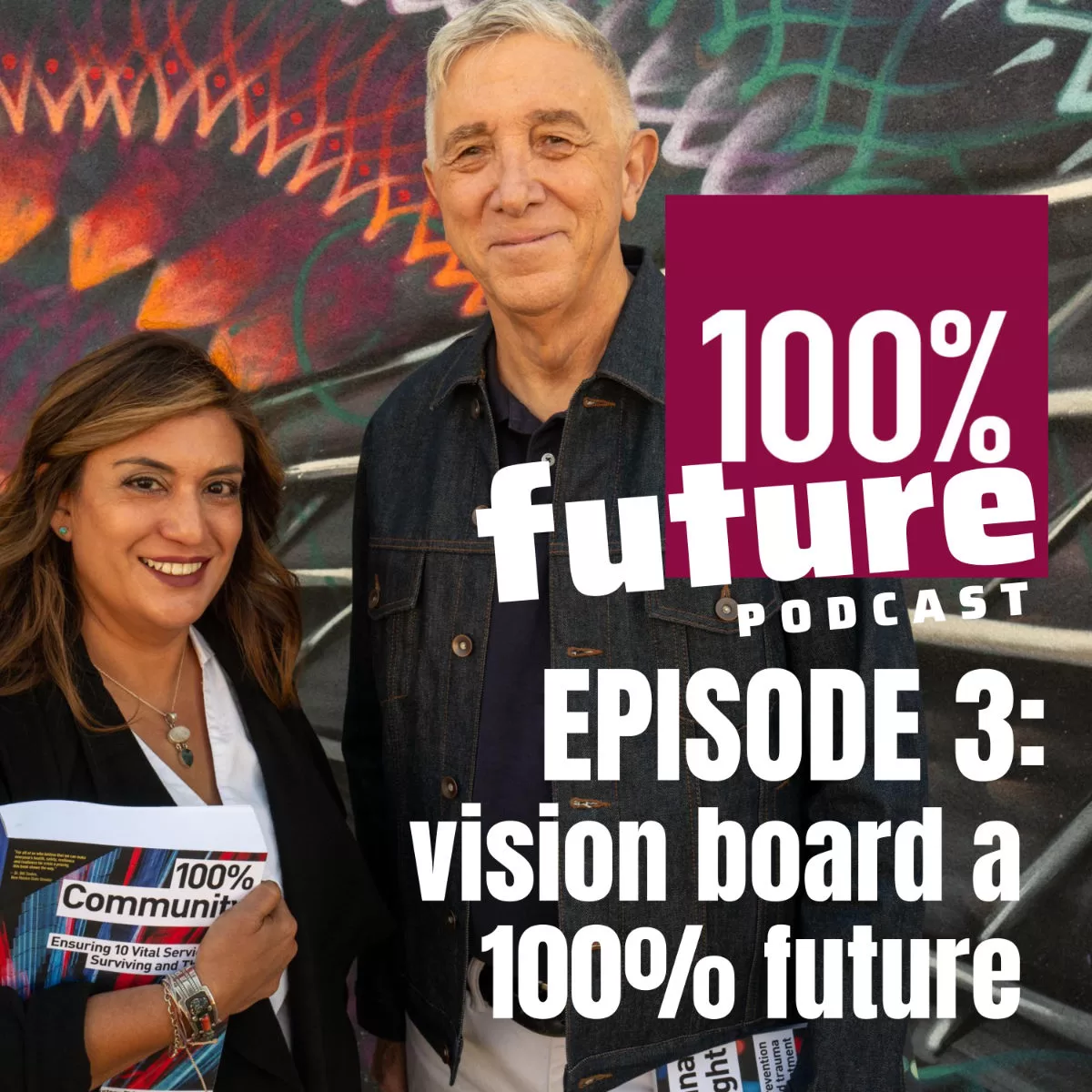Episode 5: The Future of Child Welfare
In Episode 5 of the 100% Future Podcast, host Rubina Cohen engages in a thought-provoking conversation with Child Welfare experts and change agents Dr. Katherine Ortega Courtney and Dominic Cappello on the critical topic of “The Future of Child Welfare.” As the episode unfolds, the guests shed light on the systemic challenges embedded in Child Welfare systems across the nation and the urgent need for a paradigm shift. Child Welfare, they reveal, is often set up to respond only after crises have reached alarming levels, lacking the capacity to engage in systemwide prevention strategies. The data-backed insights shared by Dr. Courtney and Dominic Cappello highlight the prevalence of child neglect and its connection to government-sanctioned poverty and adverse social determinants of health. They emphasize the importance of transitioning from Child Welfare’s culture of fear around data to using it as a tool for continuous improvement. Moreover, the episode underscores that fixing Child Welfare requires a comprehensive approach, with local communities and the state-level agencies of public health, education, and Child Welfare coming together to create a shared vision for thriving families and communities. Listeners are invited to explore the ten vital services that prevent child maltreatment and engage with the 100% New Mexico initiative, a movement dedicated to building a brighter future for all. This episode provides a compelling and enlightening perspective on Child Welfare’s challenges and the path to reform, inspiring bold action in designing thriving communities, cities, and counties.
SHOW NOTES
Segment 1: Understanding Child Welfare
- Discussion on what Child Welfare is and how it is set up to fail.
- Child Welfare system is designed to intervene after problems become severe, focusing on intervention rather than prevention.
- Calls to the statewide central intake often get screened out, and investigations are not always substantiated, meaning few families receive adequate support.
- A majority of Child Welfare cases involve neglect, often linked to lack of access to vital services.
- Highlighting the need for a broader systems approach to address Child Welfare’s shortcomings.
Segment 2: Challenges in Child Welfare
- Challenges in the Child Welfare system include a lack of coordinated services, data-driven decision-making, and a culture of fear surrounding data.
- The importance of a shift in culture to view data as a tool for improvement rather than punishment.
Segment 3: Fixing Child Welfare
- The need to acknowledge that Child Welfare issues require a comprehensive systems approach, involving multiple agencies and services.
- Mention of the 100% Community initiative, which aims to address Child Welfare challenges at the local level by addressing root causes..
- Emphasizing the importance of community involvement, shared vision, and engagement with state-level agencies to bring about lasting change.
Segment 4: Ten Vital Services
- Reference to the ten vital services for surviving and thriving discussed in episode 2 of the podcast.
- Encouragement for listeners to explore episode 2 for an in-depth understanding of these vital services.
Conclusion
- Thanking the guests for their insights and participation.
- Inviting listeners to engage with the 100% New Mexico initiative and follow it on social media platforms for more updates.
PODCAST TRANSCRIPTION
RELEVANT LINKS & RESOURCES
- Anna, Age Eight: Download the book for free https://www.100nm.org/books/
- Videos: https://www.100nm.org/videos
- CYFD 360 Report https://www.cyfd.nm.gov/wp-content/uploads/2022/12/360ANNUAL_FY21_FINAL.pdf
- Facebook: https://www.facebook.com/100percentNewMexico
- Instagram: https://www.instagram.com/100percentNM
Episode 5 Transcript
Transcript edited for clarity.
Intro [00:00:01] There’s no reason for people in a society as wealthy, resourced, and technologically advanced as this one to not be thriving. Every crisis we are exposed to hourly is completely predictable and preventable if we connect to a shared vision of everyone thriving. Surviving the day is just not acceptable anymore when we know that thriving is actually possible. Welcome to the 100% Future podcast, where Dr. Katherine Ortega, Courtney, Dominic Cappello, and me, Rubina Cohen as your host, share insights, action plans, and inspire you weekly to take bold action in designing thriving communities for all.
Rubina Cohen [00:00:51] All right. And welcome back, everybody. We are back in the studio again with Dr. Katherine Ortega Courtney and Dominic Cappello. We have an amazing topic for you all today, the future of child welfare. And I’m your host, Rubina Cohen, and I have so many questions for you both. You are both doing amazing work. Just coming off of the heels of an amazing community forum with 20 different counties represented in the room, I know you guys are exhausted. Thank you for being here. And let’s get to this important topic. Welcome.
Dr. Katherine Ortega Courtney [00:01:29] Thank you.
Dominic Cappello [00:01:30] Thank you.
Rubina Cohen [00:01:31] So I want to know, what is child welfare? And one of the questions I think that’s out there is how is it set up to fail?
Dr. Katherine Ortega Courtney [00:01:42] Child welfare is a system that is really set up to intervene after things get bad. I think a lot of people don’t understand that. I was surprised once I left Child Welfare, which I worked at for years, how little people actually understand about that system and what it actually does. Basically the way it works is a call is usually placed to what they call the statewide central intake, which is a hotline number that people can call if they have concerns about a child. What I think people expect is that after that, something happens. But, over half of the calls that are made are screened out. Over half of the calls that are made about a child (where) there is a concern, nothing happens. Those get screened out. A little less than half get referred to what’s called an investigator (and) that would be at a local county (child protective services) office and an investigator gets assigned (to a case) and then (he or she) go out and talk to the child, checking out what’s going on in that child’s life. Of those (cases), the vast majority are not substantiated. So, again, very little happens for those families. (For a case to continue) it has to be pretty severe (related to child safety). What they look for is safety at the end of the day. Is a child safe in that home? If they’re not, then that’s when they get pulled into foster care. Now, as you can imagine, foster care is very disruptive and traumatic and not ideal. What we saw while we were working in child welfare was a system that’s set up to intervene when things are bad. And there were very few opportunities to do anything to help prevent things from getting really bad. (This) is why we landed on what we need (which) is a system of support for parents before things turn into a safety issue, before kids are in danger of being severely beaten or having a home with drugs lying around where they’re in danger of ingesting them, or whatever (the maltreatment) may be because the system was legally set up to intervene later. And what I think people don’t understand is when a call is made (to the child abuse hotline), if (you’re) a concerned citizen or you’re a teacher and you’re seeing a kid coming to school with dirty clothes or some things that are concerning, you would hope that you could make a call and then somebody would come and do something about that, right? Maybe the mom just needs help getting a job or finding stable housing or getting access to food. There’s no system for that. (This) is why it is so important to build that safety network, which is really what 100% Community (and the 100% New Mexico initiative) is all about. That’s why child welfare is set up to fail. There is no system to prevent people from ending up in child welfare. If you’re ending up in child welfare, you are in a bad spot, and things are really bad for those kids in that family. It’s really hard (for families) to get back on (their) feet after something like that.
Dominic Cappello [00:05:03] I would like to add that when I got to child welfare, and that’s when I met Katherine many, many years ago, the first thing I asked for was the org chart. I was in the domestic violence unit when I started in child welfare. Because I’m kind of a systems guy, I thought, “This unit, where does this fit within Child Protective Services?” I knew there were many units, divisions and programs. I thought, “Well, why don’t I just look at the org charts?” And I kept asking for the org charts, and I kept not getting an org chart, and (staff) couldn’t find any. I asked the training people, and these are the people that you normally meet when you come into the child welfare system and they thought they had some (org chats), but they couldn’t find them. So, I offered to design the org charts, which meant I did informational interviews with the heads of all the different entities, and it was a really interesting process. I actually had graphic (flow charts made). I made it as clear as I could, and people were saying to me, “Wow, I had no idea that that entity did that or we were connected to that entity.” There was a lot of confusion between all the entities. We weren’t one big system that worked together with the knowledge of what everyone was doing. So, imagine an organization that was a private company. Their products or services would not get out the door. They would not be in business very long. I think that… and Katherine and I always want to stress this, the people we met working in child welfare were amazing people—some of the biggest-hearted, most caring people you ever meet. It’s not the employees, it’s the system itself that is set up to fail.
Rubina Cohen [00:07:08] Right. Both of you have mentioned that in past podcasts and in all the conversations that we’ve had, that this is systemic, and the format and the container in which this work is happening is not set up to help them succeed, and so then the child is failing. So, why do families enter the system, and what does the data tell us?
Dominic Cappello [00:07:38] That’s a great question. We do a lot of training, and we talk about what’s the root cause or root cause analysis. We like to know why. And this is not a question that’s always asked when you work in the public sector. There are very visionary people working in the public sector who absolutely ask that question, but that’s not the norm. The government tends to be very reactive, so they’re not going upstream. If you want to ask, “Why do families enter the system?” (or) “Why do families become so dysfunctional” or “Why do households become so unsafe that law enforcement and child welfare are called in?” we have to go back to another topic that we talked about earlier, which would be the social determinants of health. This is a term our listeners will get very used to. What are the services that determine a child’s health, safety, education, and overall quality of life? These are services and they’re also community environments. We certainly don’t want toxic environments and we certainly don’t want a bleak community that has very few services. We have to go upstream and see when that child is born, (and be engaged when) that mom and baby go home. Where is the home? Can the mom get to medical care, behavioral health care, food security, housing security, and transportation? We talk a lot about the five services for surviving. If those services are not in place, you can expect trouble in the home. And we’re not even talking about the services for thriving (yet). And we really like to talk about those… parent supports, early childhood learning programs, fully-resourced community schools, and so on. When you want to know why families enter the system, (it’s because) they don’t have services. And also, there is a generational cycle of adverse childhood experiences. When you grow up in a very violent or dysfunctional home, and if you don’t get help, you don’t get treatment, you may find yourself as a parent doing some of the same things that aren’t helpful for the child. This is why we have to get in early and this is why (we apply) systems thinking. If we want a future where we put child welfare out of business because it’s no longer needed, we have to go to every county in the state and make sure those vital services are working. And as for data, our initiative surveys the county. We are asking parents, to what degree can you get to these ten vital services? So we know. We know the problem. We know the solution. We just need to get to a future where there is the political will to solve this problem.
Dr. Katherine Ortega Courtney [00:10:53] And, going back to child welfare specifically, why do people end up in the system? The vast, vast majority of reports are about neglect. And that’s another common mistake people make about child welfare is they think it’s physical abuse or sexual abuse. The vast majority of cases that are substantiated are neglect. So that means… no food, being left alone, left in unsafe conditions, and things like that. Which often (and we got asked this a lot when I was in the data unit at Child Welfare) are directly related to poverty. Right? It’s not a crime to be poor, but when kids are in these situations, very often they end up in the system because of lack of access to resources. Parents, by and large, have the kid’s best interests at heart. Which is another common mistake people make… (They think) these parents are awful (and they do) evil things. No. They’re, in many cases, doing their best and have ended up in situations that they just can’t get out of because they can’t access the resources they need. And I pulled up what they call the 360 Report at CYFD (the Children,Youth, and Families Dept.), which is actually a report that Dominic and I designed (years ago) and they’re still using that format, which is kind of fun to look at. But it still holds true (even though) this data is about two years old, but of (all) the cases that are actually sent to an investigator, over two-thirds are about neglect versus any other type of abuse.
Rubina Cohen [00:12:39] This is such a large issue, but I know that the 100% New Mexico initiative is already identifying some of the simple solutions. (The challenges are) large and they’re hard and it’s hard work, but they’re really quite simple to solve (with buy-in). Dom, you say that quite often, and I like to repeat it because I think that’s what motivates us. So, how do you start the process of fixing child welfare?
Dr. Katherine Ortega Courtney [00:13:07] I think one of the first things that needs to happen is admitting that this isn’t a child welfare problem. This is a systems problem. This is a societal problem. How do kids end up in this situation? It is not going to get fixed if we only leave it up to one agency to fix it. It’s just not. It’s going to take behavioral health, medical care, food services, and housing. All of those survival services that we talk about are not housed within CYFD. They are not housed within child welfare. But these are the services people need to be able to navigate that system, (to) get out of the system, (and to) get the parents what they need. So I think a huge first step is acknowledging that this is not a CYFD problem.
Dominic Cappello [00:13:57] We do get asked a lot about child welfare’s future. And when we wrote Anna Age Eight, we devoted a chapter to fixing child welfare and some of our suggestions included becoming a data-driven agency. Look at the data. If you work in child welfare and you see that a county has very few services for families, that should be a red light going off. But, the way child welfare is designed today, they don’t have the resources to really do anything about that. So, as Katherine said, child welfare has to connect with the Department of Public Health. It has to connect to the Department of Public Education, (and) the departments related to housing (and) to food security. Every state has state departments (of child welfare, health, education, etc.), right? And they all work for the governor. So the governor has incredible power to make sure that these agencies are run by people who understand data and who understand research. But these are also bureaucracies… and that means they operate very differently from the private sector. Corporations (have) be working or they’re out of business. That’s not the case with the government. They’re not going to go out of business. But there are lots of child welfare systems that are data-driven (and) that are looking at these connections (between agencies). Some child welfare systems are built within county government, (giving them) direct access to these services. So, there are many models out there to actually solve the problem of child welfare. But it has to start with the understanding that child welfare alone will not fix child welfare. But it’s completely fixable.
Dr. Katherine Ortega Courtney [00:16:04] I just want to add to one thing that Dom and I did a lot of work on in child welfare… to try to change the attitude of fear. It is such a fear-based system and organization that people are afraid of data because it might show that things are not going well. Right? And we use that whole metaphor a lot, “Data is a flashlight, not a hammer.” I think there is still a lot of fear about if we let these numbers (related to kids in the system) out or if people see that kids are coming back into (child welfare) care, it’s bad, and we’ll get in trouble. (But) if we don’t have the information, how are we going to know what to fix and how to fix it? And so I think the (child welfare) culture needs to change in such a way that data is not used as punishment. It’s open. It’s used as (part of) a continuous quality improvement system, which is what we really tried to build into Anna Age Eight, and what we use in 100% New Mexico. Data points (guide us to) what’s wrong so that we can fix it, not so that we can get people in trouble.
Dominic Cappello [00:17:14] I’d like to add that when Katherine and I were (at child welfare), we saw that people were afraid of data, so we invented a data leaders program for child welfare. This was a nine-month training program, and the county managers across the state were invited to come in, and we worked with them on understanding data (and) understanding research. We were using the framework of continuous quality improvement. It’s a four-step process. We assess, we plan, we act, we evaluate. And they all took on projects that would help their county and presented them at a big graduation ceremony in Santa Fe. And the reviews we got were very positive. We (had) three cohorts, and we kept growing, (there was) good buzz. More people wanted to get into the program… and then it was just stopped. A data leaders program can be very helpful for child welfare and it can be very helpful for every state agency. And that guides our 100% Community initiative. We are data-driven. (It is) as Katherine said, “It’s a flashlight.” (The data) helps us find our way to the future.
Rubina Cohen [00:18:41] I love the flashlight analogy… metaphor. A couple of things that you both mentioned… I think that the work that you guys have been doing and the contributions that you made to child welfare seemed very helpful. But also, it really points to what you both are saying and that we can’t just look at one department or one organization to fix this larger issue that we’re dealing with… child maltreatment. I want you both to talk a little bit about what will it finally take to address child maltreatment and how is 100% New Mexico initiative working towards that.
Dominic Cappello [00:19:28] I think you can look at (using) our philosophy with 100% Community. (For) 100% New Mexico… with our 33 counties that we’re working with and reaching out to… change happens from the ground up. We’re working on the local level to get stakeholders together to talk about the issue, to talk about adverse childhood experiences, to understand the social determinants of health, and to see how they can collaborate. We need that. We need to grow from the bottom up like a house and a plant. We start in the soil and we grow up. But we also need (at) the top state levels—which are multi-million-dollar enterprises—(the agency’s leaders) on board, too, with a shared vision. (We need) a shared vision on the bottom and on the top. And they’re going to meet in the middle. And I think that’s what that’s what 100% is doing. It’s understanding that change happens on many, many levels, and you have to be working on all levels. But if it doesn’t start on the ground level and if you don’t get buy-in, nothing’s going to stick.
Dr. Katherine Ortega Courtney [00:20:44] I think that’s exactly right. I think what we’ve learned is that there is a huge number of people who want kids to grow up in safe and thriving communities. And provided with a framework, they take off and do it. We have had people knocking on our door for five years now, ready to start this initiative in their communities because they’re tired of seeing their families struggle… and the same kids come in and out of child welfare. Dom’s exactly right. It takes the community first. But eventually, the systems are going to have to follow because they’ll have to… because they’re going to have to think differently.
Rubina Cohen [00:21:26] Yes, I love that. I think we’re no longer just thinking, “It’s about a neighbor’s kid, or my kid.” We need to be looking at this as a big picture. Does my whole community—is everybody—thriving? Does everybody have access (to services)? And that is a systemic look at how we’re going to change this. I really appreciate you both being here again for today’s episode. Dr. Katherine Ortega Courtney mentioned the ten vital services that we did go through in depth in our episode two. So if anybody wants to go and check out episode two to learn more about what those ten vital services are, they can go check it out on our (podcast) blog and we’ll have those links in the show notes. Thanks, everybody, for being here. We’ll see you next week.
Dr. Katherine Ortega Courtney [00:22:21] Thank you.
Dominic Cappello [00:22:21] Thank you.
Rubina Cohen [00:22:24] Join us on the road to 100% New Mexico Initiative at 100NM.org to learn more and get access to the podcast show notes. Want to stay more actively engaged with the movement, then follow us on Facebook at 100percentNewMexico and on Instagram at 100percentNM. Until next time, let’s take bold action to create a 100% future for all.




